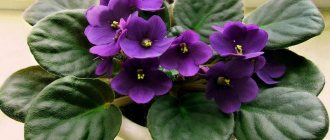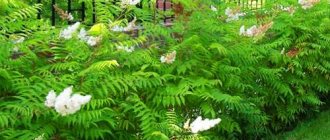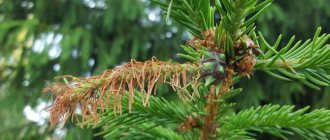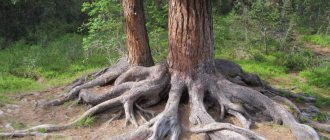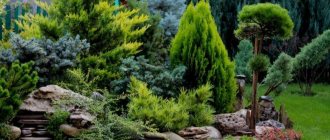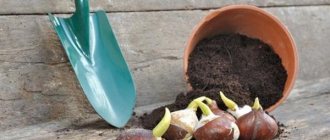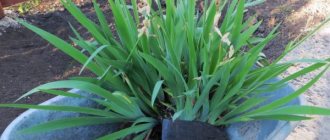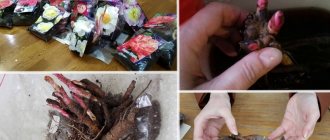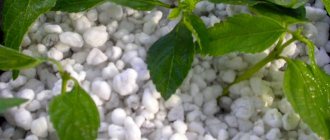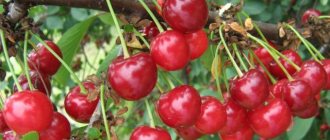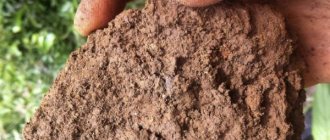Features of soil for coniferous plants
The optimal soil composition for all coniferous representatives is considered to be a mixture of the following components:
- peat (can be replaced with marsh duckweed);
- sand (preferably using river sand);
- humus;
- turf land.
There are a number of nuances that should be taken into account when choosing soil for conifers:
- An important factor is the soil structure. The ideal option is a “sponge” state, so that at least a quarter of the soil is occupied by pores. Calcium will help achieve this.
- Each type of coniferous plant has its own requirements regarding substrate moisture. For cypress and fir trees, the same proportion of humidity and air permeability is important, and junipers are demanding in terms of filling the soil with air. Fir trees can endure many hardships, but excess moisture in the substrate can be detrimental to these coniferous plants.
- Most representatives of conifers can grow safely only in a substrate with a high acidity level, and some of them, on the contrary, prefer a calmer acidic “atmosphere”. Therefore, this fact must also be taken into account when choosing soil.
The correct choice of soil for each species will help you avoid numerous problems associated with growing coniferous plants.
Preparing the planting hole
Once the type and variety of needles has been selected, it’s time to start planting. First, you need to decide on the place where to plant the plant. In this case, the future size of the plant must be taken into account so that it can easily grow both in height and width. The planting site must meet the necessary requirements of the selected variety and, of course, the soil for the coniferous plant must be prepared in advance.
First, a hole of the required depth for a particular type of coniferous plant is dug, approximately 2 times wider than the earthen clod. Part of the excavated soil can be left if it is quite loose and fertile. At the bottom, if the selected plant requires it, a layer of drainage is laid out; you can use broken brick, sand or gravel for this.
Before planting, the roots of the seedling should be dipped in water along with a lump of earth so that after transportation they are saturated with moisture. Then the plant must be lowered into the hole and be sure to make sure that it sits vertically. The hole should be filled with a pre-prepared substrate or soil for coniferous plants purchased at a specialized store.
After planting, a small ditch is dug around the hole and filled with plenty of water. As soon as all the moisture is absorbed, the ditch is covered with earth and mulched, but so that a small depression around the perimeter remains and prevents the plant from being flooded. Peat, freshly cut grass or humus can be used as mulch.
Soil for spruce trees
The main condition for caring for evergreen spruce is the correct selection of soil. The plant is a mycotroph (it has the ability to form symbiotic relationships with the hyphae of earth fungi, which facilitate the absorption of microelements from the soil). In view of this, the acidity of the substrate suitable for planting spruce should be in the range of 4.5 – 6.0 pH. At higher values, the soil is enriched with bacteria that suppress the growth of fungi that are beneficial to the plant.
Another important condition that the spruce substrate must meet is good aeration. Spruce can grow safely on sandy and poor soils, but it does not tolerate stagnant moisture. One rainy season is enough for a tree to die.
Attention! If the tree is planted in the scorching sun or in deep shade, then even high-quality soil will not guarantee good growth.
Soil for pine trees
The soil for conifers, which includes pines, should be sandy or sandy loam. When planting pine in clay soil, additional drainage will be required. You can use broken bricks, expanded clay crushed stone, and river sand.
Before planting coniferous seedlings, it is also necessary to add nitrogen fertilizer. It will start working after a couple of weeks.
The acidity of the substrate is also taken into account when planting types of pine such as Weymouth and black. These representatives of conifers prefer neutral or alkaline soil. Acidity can be reduced by using ordinary lime, which is added to the planting substrate. The amount of lime should be in the range of 200 - 300 g.
Soil for junipers
Juniper is not so picky about the composition of the soil; it can grow in loamy areas that have a weak drainage system, rocky soil and sandstones. But for young seedlings it is better to give preference to the following mixture of components:
- peat – 1 part;
- turf soil - 2 parts;
- river sand – 1 part.
You can also add a universal fertilizer (nitroammophoska) to the mixture, which can be used for most garden and vegetable crops.
If this representative of conifers is planted in loamy soil, it is best to organize additional drainage for it using improvised means - brick chips, pebbles, etc.
When planting a coniferous plant in rocky soil, you need to pay attention to the surrounding vegetation. If there are a lot of weeds around the proposed planting site, then it will be a favorable option for placing juniper seedlings. This trick is used not only by Russian gardeners, but also by American specialists in growing coniferous plants.
Juniper
One of the lowest types of conifers with a height of 50 centimeters to 5 meters. Trimming the crown allows you to make them of different shapes, and due to the fact that they grow rather slowly, you will not have to do this very often. Juniper should be planted in an open place so that the sun always illuminates it.
He likes soil made from peat, sand and turf. For planting, dig a hole 50-70 cm deep and make a drainage layer of 15 centimeters, but no less.
Fir should be fertilized no more than once a month with organic fertilizers, such as vermicompost, but only if it grows more slowly than it should. Water it about once a month during dry summers. It is also advisable to spray fir needles once a week early in the morning or in the evening, when the sun's activity is not very strong.
Land for larches
Like junipers, larches can live in almost any soil. Representatives of conifers, whose natural habitat is sphagnum bogs, will benefit from soil with high acidity (pH 3.5 - 5.5). Species growing in mountainous areas will thrive on alkaline substrates (pH 7.0 and above). For the rest, a substrate with neutral acidity is suitable.
Despite the fact that in nature larch can grow in wetlands (the exception is American and Japanese larch, as well as Griffith), where the substrate has poor drainage and aeration, selected species are more demanding. “Domesticated” varieties can suffer from excess moisture, even to the point of complete death. Drainage equipment made from brick particles, expanded clay crushed stone or pebbles will help reduce the risk of unfavorable situations.
The soil considered optimal for larch can be loamy or contain sandy loam. Acidity can be normal or weak, humidity - medium or high.
Soil for cedars
Soil for conifers, the composition of which varies depending on the type of plant, almost always contains a large amount of sand. Cedar prefers sandy or loamy substrate, in which even young seedlings take root well. If it is clayey at the planting site, then to improve the growth of the tree, it is recommended to dilute it with sand and peat (2 parts of soil require the same parts of sand and 1 part of peat).
Many gardeners add a number of fertilizers to the soil:
- wood ash;
- humus;
- coniferous soil from the forest.
Important! You need to prepare the soil immediately before planting by removing a lump of earth and mixing all the above components with it.
Soil for coniferous plants such as cedars can be brought from their natural habitats. If the seedling was taken from a specialized nursery, then there is a possibility that the young plant is accustomed to more tolerant growing conditions. It is important to take this point into account when purchasing cedar, since this factor affects the proportions of the components that make up the soil. For pampered individuals, the amount of sand must be doubled.
Comments (4)
Ivan
12/21/2019 at 12:51 |
In my experience, coniferous trees are quite unpretentious; there are no coniferous forests in our region, but at the same time I had to plant pine and spruce trees in the most ordinary soil, which took root normally. But it didn’t work out with cedar,Answer
Yulia Expert Plodogorod
01/05/2020 at 21:10 |
Hello, Ivan! As for unpretentiousness, this is not true for all conifers. There are varieties that are tolerant of any soil composition. If, at the same time, the care and living conditions are suitable, the plant will develop normally. Some, especially decorative conifers, are very capricious. In addition to creating conditions for them, you need to use growth and root formation stimulants.
If you decide to plant cedar, the land must be prepared in advance and made drained. Loamy, sandy loam, podzolic soil is suitable for this crop. Cedar will also develop well in sandstone and black soil. Only clay and marshy soils are not suitable.
Due to the wide distribution area of cedar, this tree normally tolerates some deviations in the composition and structure of the soil from optimal ones. If the seedling died, it may have been weak to begin with.
When purchasing, we recommend inspecting the plant. It is important that there are no growths, spots, dry or rotten areas, or mechanical damage on the stem. The roots should be elastic and well developed. Transplantation is better tolerated by seedlings with a closed root system.
Answer
Andrey
01/16/2020 at 11:20 |
Cedars are the most popular among gardeners and home garden owners. I planted two cedars, mixed peat with sand and seasoned them with nitroammophoska. The cedars are now five years old and growing well.
Answer
Yulia Expert Plodogorod
01/17/2020 at 18:58 |
Hello Andrei! In addition to correct planting in prepared soil, such cedars, like other conifers, require some care. Basically it comes down to loosening the area near the plant and watering.
It is advisable not to wet young plants with cold water. Conifers of this variety respond well to sprinkling in the morning or evening. During hot and dry summers, watering should be abundant and frequent, otherwise the crop may dry out or lose its decorative effect.
Since your seedlings are already five years old, they will soon need to be planted in a permanent place. Typically, this procedure is carried out for trees that have reached six years of age. It's better to do this in the spring. Before transplanting to a permanent place and for the first time after it, it is better to shade young cedars from intense sun.
These coniferous plants are often affected by Hermes. A sign of pests is a cotton wool-like coating on the crown. If it is noticed that more than 30% of the crown is covered with such plaque, you need to treat the crop with an insecticide, for example, Fufanon.
It is better not to apply nitrogen-containing fertilizers in large quantities, but cedar trees respond well to potassium.
Answer
Soil for thuja
Another representative of coniferous plants is thuja. It prefers soil that contains a lot of microelements, moisture and drainage. The optimal substrate option is a mixture of peat and sand (1 part each) with soil (2 parts). Its acidity should not exceed pH 5 - 6.
If there is loamy soil on the site, then a year before planting a coniferous plant it must be brought to the appropriate parameters by adding the above components to the soil. As a drainage system, it is permissible to use coarse sand, pebbles or small crushed expanded clay, as well as fragments of baked brick.
What to do with the plant after the holidays
But now the fireworks have died down, the bells have rung and the traditional time for receiving guests has ended... We are wondering about the future of the coniferous tree.
Most potted “Christmas trees” are open ground plants; for successful growth and development they need a cool winter and moist air. How cool is it and where to provide it - a window sill, a cold or insulated balcony (loggia), a winter garden, a summer house?
Now we urgently need knowledge about the species of the “Christmas tree”, because from it we can judge the winter hardiness of the plant. Heat-loving plants are often found on sale: Italian pine 'Silvercrest', as well as "Turkish firs", one of the parents of which is Greek fir. Of course, such beauties from the far south will not survive the harsh winter of central Russia. The average temperature of their winter maintenance ranges from +4°C to +10°C, which, of course, cannot be ensured in residential premises.
Their salvation can be a frost-free balcony with the possibility of heating or (at worst) a stairwell. Such a plant must be given the brightest place and provide minimal watering, preventing the earthen clod from drying out.
If you decide to keep your “Christmas tree” in your apartment or plant it in the garden, first find out what type and variety it is, understand whether this plant is winter-hardy
Please note that the vast majority of potted “Christmas trees” come from Europe, which means that even winter-hardy species in the middle zone (which are still the majority among potted spruce trees) will need shelter in the garden for the first 2-3 winters, because where they come from, winters much softer than Russian ones.
The wintering of cypress trees is quite problematic: K. Lawson, K. obtuse and K. thuja (its cultivar 'Top Point' is most often found as a New Year's tree), Nordmann fir (sellers call it Danish spruce) and P. monochromatic, thuja folded 'Gelderland', black pine 'Oregon Green', Chinese juniper 'Stricta', as well as Geldreich pines 'Malink' and 'Compact Gem', popular in Europe.
My advice is that it is better to grow them in the southern regions of our country, but if you want to try to save the tree and plant it in central Russia, then they should be carefully buried in the snow and eliminate the possibility of burning in early spring.
In the first 2-3 years, the young plant will need shelter for the winter, even if it is suitable for your region in terms of winter hardiness
We take it to the dacha
You can take to the dacha Fraser fir, Arizona fir (sometimes it is considered as a variety of subalpine fir), Scots pine, western thuja, rock juniper ('Moonglow' and other cultivars), Serbian spruce, e. Canadian, e. Scots, e. prickly. It is enough to simply bury them “headlong” in a snowdrift - if there are no serious thaws and subsequent severe frosts, the trees will overwinter well, and in the spring they can be planted.
Please note that spring dangers threaten Canadian spruce 'Conica', Chinese juniper 'Stricta' (early spring burns), subalpine fir and Siberian fir (damage to young shoots by late spring frosts). To prevent burns, it is advisable to install a border shield or pre-wrap the plant with a border mesh or burlap.
In spring, coniferous plants must be protected from burns
Digging in the shade is undesirable - there the snow lasts longer, which means the growing season begins later. Temperature changes are extremely undesirable for any conifer, so before moving to the country, especially if there is severe frost, it is better to keep the plant on a frost-free balcony for 3-5 days.
We leave it in the apartment
If this is not possible, you can leave it on an uninsulated glazed loggia with the obligatory covering of the root part (as a rule, on such a balcony the temperature is 5-8 degrees higher than outside). The last option is the window sill of the staircase (the main thing is that no one likes the tree).
Miniature coniferous trees (thuja 'Can-Can', blunt cypress 'Teddy Bear', Canadian spruce 'Conica') can be grown on a balcony or loggia for several years. Frost-free rooms are best suited, but you can also leave them on a cold glazed balcony (loggia) provided there is high-quality shelter, especially a container.
Please note that on an uninsulated balcony only species that are more winter hardy than necessary for open ground will grow without problems. But even if they are very winter-hardy, I still recommend covering their root system, because in winter conifers on the loggia find themselves in harsher conditions than in the garden. Well, less winter-hardy species (zone 4-5) require shelter without fail.
The “Christmas tree” that you decide to keep will need to be replanted without disturbing the root ball
The soil in which the plant was sold must be replaced in the spring. The lump should not be completely destroyed, and if it is tightly entwined with roots, you need to choose a container with a diameter of 4-5 cm larger and add fresh soil (either specialized for conifers, or make a mixture of turf soil, sand, peat and pine litter). Every year it is recommended to replant (transfer) the plant, increasing the diameter of the container by 3-5 cm (depending on the growth rate of the tree).
The feeling of the holiday is given to us not only by the New Year's tree, but also by the corresponding decor. If you like to create jewelry with your own hands, be sure to watch our master classes:
- Author: Maria Sukhorukikh
Rate this article:
- 5
- 4
- 3
- 2
- 1
(0 votes, average: 0 out of 5)
Share with your friends!
Soil for fir trees
Fir is quite whimsical compared to its fellow conifers. Well-drained loamy soil that does not retain moisture is suitable for it. In a dry place, a coniferous plant can quickly die, just like in a waterlogged one. The best option is a site located near a reservoir, where the soil will meet all the necessary parameters.
Attention! Stagnation of water can lead to the development of fungal pathologies in fir.
Loosening the soil for conifers
An important stage in caring for coniferous plants is loosening the surface layer. Important in the sense that before you start practicing, you should understand how and why it should be done.
The microflora inhabiting the soil necessary for this crop is divided into aerobic and anaerobic. Too frequent and deep loosening will have a detrimental effect on the life of those microorganisms for which oxygen is destructive; the lack of loosening will destroy the aerobic microorganisms, which require oxygen.
Therefore, loosening can be carried out several times a season, because frequent shifts of soil layers will destroy the necessary microflora. This does not apply to those subspecies for which it is necessary to create high-quality aeration.
Land for cypress trees
Experienced gardeners prepare soil for conifers, the composition of which can be called ideal, on their own. Despite the availability of balanced mixtures in stores, those who want to start growing cypress make a substrate from the following components:
- 3 parts of turf land;
- 2 parts of pine humus;
- 1 part sand.
In the absence of coniferous humus, it can be replaced with peat, but the quality of the soil will significantly decrease. To improve performance, it is recommended to add a small amount of clay and vermiculite to the mixture.
Important! Growing cypress trees on peat alone can be a temporary measure. At the first opportunity, the plant should be transplanted into a higher quality substrate.
If making your own soil is not possible, then azalea soil will be the best option for this coniferous plant. It contains the necessary components that ensure the necessary acidity of the soil.
Soil for yews
Yew prefers light soil. Despite this, it should contain a large number of microelements. Gardeners have their own opinion regarding the composition of the substrate for yews:
- 3 parts of turf or leaf soil;
- 2 parts of pine humus or peat;
- 2 parts coarse sand.
Soil for conifers must be selected depending on the type of plant. Thus, yew berry can feel comfortable only on alkaline and slightly acidic soils. Pointed yew prefers soil with a neutral pH. For medium yew, it is better to choose slightly alkaline or neutral soil.
The main enemy of this coniferous plant is high humidity of the substrate, as well as a polluted environment. If the first point regarding the moisture level can be easily corrected by mixing more peat into the soil and drainage equipment, then even additional application of vitamin supplements will not help in the fight against environmental pollution. Therefore, yew is never planted within the city.
Transplants
It is preferable to replant coniferous plants during the dormant period. And the older the seedling, the more strictly it is necessary to follow this rule. It is customary to replant large-sized plants with a good clod of soil (this is provided by the seller or nursery) either in the fall or in the winter (special technology). Plants in containers can be replanted throughout the growing season. For better survival, be sure to thoroughly wet the root ball (soak it in plain water for at least a day). Particularly careful farmers can be advised as a second step to soak the lump in a solution of one of the root system growth stimulants: Zircon, Humate, Ecogel, etc. But the duration of this stage should not exceed 15-20 hours. Otherwise, the process will begin to be inhibited. Soaking procedures can be carried out without removing the container. If the container is large, then after planting it is necessary to thoroughly water the root ball, and then, after 7-10 days, spray the crown with a stimulant solution.
As a rule, plants planted according to the specified rules take root well, although it has been established that complete rooting for coniferous plants occurs only after 2-3 years.
What you should never do is purchase planting material for coniferous plants with an open root system. The plants will definitely die and no amount of soaking will help.
